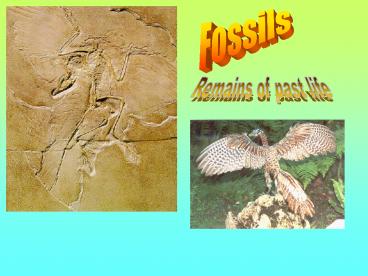Remains of past life - PowerPoint PPT Presentation
1 / 20
Title:
Remains of past life
Description:
Amber. Original remains stuck in a sticky resin from the trees. Body of the insect preserved ... New Jersey, when he heard that twenty years previous, workers ... – PowerPoint PPT presentation
Number of Views:298
Avg rating:3.0/5.0
Title: Remains of past life
1
Fossils
Remains of past life
2
Yeah- you gotta take notes!
3
What is a fossil?
- They represent evidence of earlier life.
- They are our only link to the living past.
- They tell us of ancient environments and organism
habits. - Many times they are used to help distinguish
periods of geologic time.
4
- Fossils as Evidence For Evolution
- First organisms were simple in structure
- As time passed, life forms increased in size and
complexity - The rock record shows that through time many
organisms disappear and are replaced with new and
different organisms - The evidence indicates a changing or evolving
pattern of life forms - This process of change that produces new life
forms over geologic time is called EVOLUTION
5
(No Transcript)
6
Petrification-Replaced Remains
- Means turned to stone.
- Types of organisms fossilized
- Wood
- Bones
- Teeth
- Shells
- How the process works The original remains are
replaced by minerals. - We can learn about what the original organism
looked like and reconstruct environments
7
Petrification The original shell gets buried
8
...over time more layers form over top as water
perculated between the grains
9
...and replace the original material with minerals
10
Casts and Molds
A shell is deposited in mud. The shell dissolved
over time, leaving a cavity in the rock (and a
good impression of itself). The cavity is the
mold. The cavity later fills in with mineral
substances. This forms a cast.
11
Original Remains
Freezing
Type of organism fossilized Wooly Mammoth
Body is preserved
Some scientists think that DNA can be preserved
12
Amber
Original remains
- Original remains stuck in a sticky resin from the
trees - Body of the insect preserved
- Insects mostly
- Tells us a lot about the organism
13
The World Famous La Brea Tar Pits The Rancho La
Brea Tar Pits is one of the world's most famous
fossil localities, located 5 miles west of
downtown Los Angeles. Near the end of the Ice
Age, about 40,000 to 10,000 years ago,
saber-toothed tigers and woolly mammoths roamed
the Los Angeles Basin. Some of these animals,
along with countless other animals and plants,
became mired in pools of natural tar - a tragic
ending for many prehistoric creatures, but a boon
for today's paleontologists studying the Ice Age.
14
Types of organism fossilized
Any prehistoric animals and plants can be
fossilized in tar. In the case of La Brea-bison,
wolves, sloths, saber-tooth cats, and camels were
found.
How the process works
The animals were trapped in the gooey tar and
were preserved relatively unchanged.
15
Impression A Trace Fossil
16
Trace fossils are the most common fossils found
in nature. They are impressions left in the
sediment from once living things. Common trace
fossils are footprints or walkways, resting
spots, living burrows, feeding burrows They are
not the original parts of an animal. A trace
fossil is preserved when mud or dirt that was
disturbed by something living hardens and keeps
its shape. They give valuable information ABOUT
the size, height, weight of the organism. Trace
fossil footprints of early humans are evidence
that they walked upright.
17
- Not an original organism.
- Waste material from animals that has been
petrified.(Dino doodoo) - Gives valuable information about what the
organism ate.
Coprolites- trace fossils
18
Index fossils
- A good index fossil must be easily recognized
- A good index fossils must have been found over a
wide geographic area - A good index fossils must have been limited in
geologic time. The organism existed for only a
short period of geologic time - Many species of trilobites are good index fossils
19
NJ State Fossil
20
In the summer of 1858, Victorian gentleman and
fossil hobbyist William Parker Foulke was
vacationing in Haddonfield, New Jersey, when he
heard that twenty years previous, workers had
found gigantic bones in a local marl pit. Foulke
spent the rest of the summer directing a crew of
hired diggers shin deep in gray slime. Eventually
he found the bones of an animal larger than an
elephant with structural features of both a
lizard and a bird. First Nearly-Complete
Dinosaur Skeleton Foulke had discovered the first
nearly-complete skeleton of a dinosaur -- an
event that would rock the scientific world and
forever change our view of natural history.































